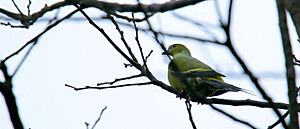Pin-tailed green pigeon facts for kids
Quick facts for kids Pin-tailed green pigeon |
|
|---|---|
 |
|
| Species Treron apicauda apicauda from Ghatgarh village of Nainital district of Uttarakhand, India | |
| Conservation status | |
| Scientific classification | |
| Genus: |
Treron
|
| Species: |
apicauda
|
The pin-tailed green pigeon is a beautiful bird found in Southeast Asia. It's also called the pin-tailed pigeon. This bird belongs to the Columbidae family, which includes all pigeons and doves.
Contents
What Does It Look Like?
The pin-tailed green pigeon is a medium-sized dove. It usually weighs between 185 and 255 grams. Male birds are about 32 to 36 centimeters long. Females are a bit smaller, typically around 28 centimeters.
These pigeons are mostly yellow-green. Their wing feathers are a darker green. The outer wing feathers are black. Male birds have a golden chest with a hint of pink. Their central tail feathers are bluish-gray. The feathers under their tail are a chestnut color.
The skin around their eyes is blue. Their beak is also blue with a lighter green or yellow tip. Their legs and feet are a bright reddish-pink. Female birds are a duller yellow. They have much shorter central tail feathers. Their undertail feathers are also not as bright.
The pin-tailed green pigeon has a soft whistling song. It sounds like ku-koo. They often sing this song in pairs. They also make a high-pitched doo! sound. When they fly, their feathers make a whirring noise.
How It Was Named
The pin-tailed green pigeon was first described in 1846. This was done by a person named Edward Blyth.
The first part of its scientific name, Treron, comes from the Greek word trērōn. This word means "timid" or "shy dove." The second part, apicauda, comes from two Latin words. Apicis means "apex" or "point." Cauda means "tail." So, its name means "shy dove with a pointed tail."
Types of Pin-tailed Green Pigeons
There are three known types, or subspecies, of the pin-tailed green pigeon:
- Treron apicauda apicauda: You can find this type in Bangladesh, Bhutan, China, Myanmar, Nepal, and Thailand.
- Treron apicauda laotianus: This type lives in the mountains of Laos and Vietnam.
- Treron apicauda lowei: This type is found in the mountains of Thailand, central Laos, and Vietnam.
Where It Lives
The pin-tailed green pigeon lives in many countries. These include Bangladesh, Bhutan, Cambodia, China, India, Laos, Myanmar, Nepal, Thailand, and Vietnam.
These birds live in forests and areas with new tree growth. They like foothill forests and tropical dry forests. They also live in evergreen rainforests. They usually live in places from sea level up to 1800 meters high.
Some pin-tailed green pigeons stay in one area all year. Others move around to find food. For example, in central Vietnam, they fly to lower areas during the dry season. This is when many trees have fruit.
Behavior and Life
What It Eats
The pin-tailed green pigeon mainly eats fruits and berries. It is a frugivore, which means "fruit-eater." They are very good at moving around to pick fruit.
These birds are social. They often gather in groups of 10 to 30 birds to eat. Sometimes, these groups fly down to the ground. They do this to visit "salt licks," which are places with salty soil or rocks.
Reproduction and Nests
Pin-tailed green pigeons have been seen nesting in April, May, and June. This happens in the Himalayan foothills. In other parts of Southeast Asia, they can breed all year long.
The female bird lays two white eggs. She builds a simple nest made of twigs. The nest is usually about 5 to 6 meters off the ground. Nests have been found in bamboo, trees, and shrubs. Both parents help to warm the eggs. They also both feed the young birds. These birds usually live for about 4.2 years.
How We Protect Them
The IUCN looked at the pin-tailed green pigeon in 2018. They listed it as a species of least concern. This means it is not currently in danger. However, the number of these birds is slowly going down.
People think this bird is common in most places it lives. But it can be hard to spot. It is rare in Thailand. It is also reported as very rare in Bangladesh.
Images for kids




